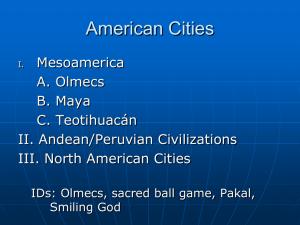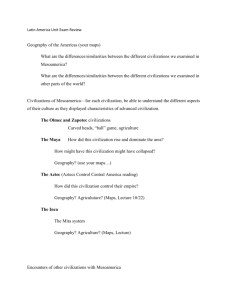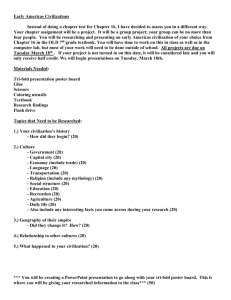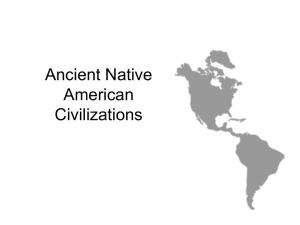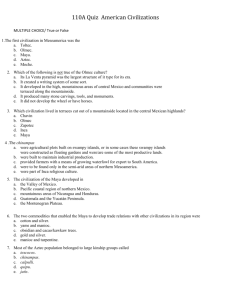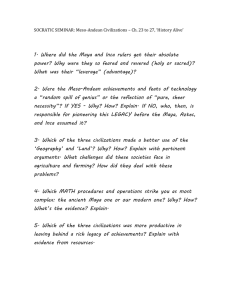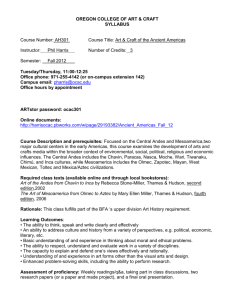Concerto Americas 500 BCE to 1200 CE
advertisement
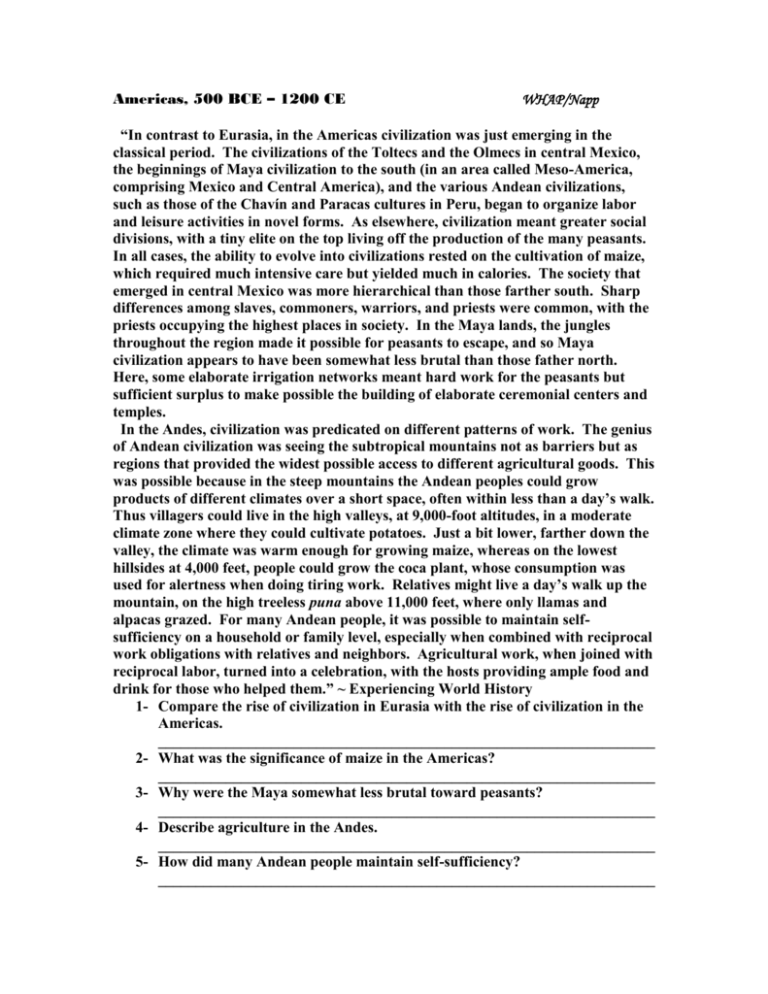
Americas, 500 BCE – 1200 CE WHAP/Napp “In contrast to Eurasia, in the Americas civilization was just emerging in the classical period. The civilizations of the Toltecs and the Olmecs in central Mexico, the beginnings of Maya civilization to the south (in an area called Meso-America, comprising Mexico and Central America), and the various Andean civilizations, such as those of the Chavín and Paracas cultures in Peru, began to organize labor and leisure activities in novel forms. As elsewhere, civilization meant greater social divisions, with a tiny elite on the top living off the production of the many peasants. In all cases, the ability to evolve into civilizations rested on the cultivation of maize, which required much intensive care but yielded much in calories. The society that emerged in central Mexico was more hierarchical than those farther south. Sharp differences among slaves, commoners, warriors, and priests were common, with the priests occupying the highest places in society. In the Maya lands, the jungles throughout the region made it possible for peasants to escape, and so Maya civilization appears to have been somewhat less brutal than those father north. Here, some elaborate irrigation networks meant hard work for the peasants but sufficient surplus to make possible the building of elaborate ceremonial centers and temples. In the Andes, civilization was predicated on different patterns of work. The genius of Andean civilization was seeing the subtropical mountains not as barriers but as regions that provided the widest possible access to different agricultural goods. This was possible because in the steep mountains the Andean peoples could grow products of different climates over a short space, often within less than a day’s walk. Thus villagers could live in the high valleys, at 9,000-foot altitudes, in a moderate climate zone where they could cultivate potatoes. Just a bit lower, farther down the valley, the climate was warm enough for growing maize, whereas on the lowest hillsides at 4,000 feet, people could grow the coca plant, whose consumption was used for alertness when doing tiring work. Relatives might live a day’s walk up the mountain, on the high treeless puna above 11,000 feet, where only llamas and alpacas grazed. For many Andean people, it was possible to maintain selfsufficiency on a household or family level, especially when combined with reciprocal work obligations with relatives and neighbors. Agricultural work, when joined with reciprocal labor, turned into a celebration, with the hosts providing ample food and drink for those who helped them.” ~ Experiencing World History 1- Compare the rise of civilization in Eurasia with the rise of civilization in the Americas. __________________________________________________________________ 2- What was the significance of maize in the Americas? __________________________________________________________________ 3- Why were the Maya somewhat less brutal toward peasants? __________________________________________________________________ 4- Describe agriculture in the Andes. __________________________________________________________________ 5- How did many Andean people maintain self-sufficiency? __________________________________________________________________ Notes: I. Civilizations of Mesoamerica A. Atlantic and Pacific oceans ensured that cultures of Western Hemisphere had long operated in a world apart from their Afro-Eurasian counterparts B. And cultures were often isolated in Americas due to geographic barriers C. Achievements but without large domesticated animals or iron-working II. Mesoamerica A. Stretching from central Mexico to northern Central America B. Shared intensive agricultural technologyMaize, beans, chili peppers, etc. C. Market exchanges, polytheism, belief in cosmic cycle of creation/destruction, human sacrifice, ceremonial centers, calendar, hieroglyphic writing D. During the first millennium BCE, Olmec civilization (a “mother civilization” of Mesoamerica) engaged in trade thereby leading to the diffusion 1. Olmec Stone heads III. The Maya A. Major classical civilization of Mesoamerica B. Ceremonial centers constructed as early as 2000 BCE in present-day Guatemala and the Yucatán region of Mexico 1. Classical phase of Maya civilization, between 250 and 900 CE a) Mathematical system with concept of zeroPlace notations in math, capable of complex calculationsCareful observation of night skies b) Predicted eclipses of sun/moonelaborate calendars most elaborate writing system in the AmericasTemples, pyramids, etc. c) By 600 CE, drained swamps, terraced hillsides, flattened ridge tops, and constructed an elaborate water management system C. Highly fragmented political system of city-states, local lords, etc. D. Engaged in frequent warfareextensive capture and sacrifice of prisoners 1. One Maya city, Tikal, contained around 50,000 people with another 50,000 or so in the surrounding countryside by 750 CE a) But no Maya city-state succeeded in creating a unified Maya empire b) More closely resembled the competing city-states of ancient Mesopotamia or classical Greece than the imperial structures of Rome 2. Collapsed with completeness rare in world history 1. Drought in 840 CE led to drop in population 2. Cities were deserted IV. Teotihuacán A. At roughly the same time as the Maya flourished, the giant city of Teotihuacán, to the north in the Valley of Mexico, thrived B. Begun around 150 BCE and built to a plan C. A population between 100,000 and 200,000Largest urban complex in AmericasBut much is unknown about the city D. Broad avenues, spacious plazas, marketplaces, temples, palaces, apartment complexes, slums, waterways, reservoirs, drainage systems, and murals E. Along the main north/south boulevard, now known as the Street of the Dead: grand homes of elite, headquarters of state authorities, temples, pyramids F. Off the main avenues, the streets are in a grid-like pattern G. But the art of Teotihuacán, unlike that of the Maya, has revealed few images of self-glorifying rulers or individuals H. City did not have a tradition of written public inscriptions as the Maya did but a number of glyphs or characters suggest a limited form of writing I. The city cast a huge shadow over Mesoamerica, from 300 to 600 CE V. Civilizations in the Andes A. Around 900 BCE, located in the Andean highlands at a village called Chavín de Huántar Shamans made use of the San Pedro cactus and its hallucinogenic properties to penetrate the supernatural world 1. On trade routes to both the coastal region to the west and the Amazon rain forest to the east became a pilgrimage site B. Moche Peru’s northern coast, flourished between about 100 and 800 CE 1. Economy rooted in complex irrigation systemgoverned by warrior priestshowever, fragile environmental foundations/drought, etc. VI. Peoples of the Americas A. Three GroupsCivilizations in Mesoamerica/AndesBut also gathering and hunting peoplesAnd semi-sedentary peoples in the eastern woodlands of U.S., Central America, Amazon basin, and Caribbean islands B. In Chaco canyon in what is now northwestern New Mexico, between 860 and 1130 CE, five major pueblos emerged C. Unlike the Chaco region in the southwest, the eastern woodlands of North America and especially the Mississippi River valley hosted an independent Agricultural Revolutionby 2000 BCE, domesticated local plant species but few plants were not sufficient to support a fully settled life What geographic factors limited contact with the Americas and within the Americas? You are the teacher. What facts must a student know about the Olmecs? You are the teacher. What facts must a student know about the Mayas? You are the teacher. What facts must a student know about Teotihuacán? You are the teacher. What facts must a student know about the Chavín? You are the teacher. What facts must a student know about the Moche? Strayer Questions: With what Eurasian civilizations might the Maya be compared? In what ways did Teotihuacán shape the history of Mesoamerica? What kind of influence did Chavín exert in the Andes region? What supports scholars' contention that Moche represented a regional civilization in the Andes? 1. As for early agriculture in 4. The heartland of early Andean Mesoamerica, it can be said that society was (A) The settlers developed food (A) The region now occupied by crops brought from Siberia. the states of Peru and Bolivia. (B) Horses and oxen played (B) The region now occupied by important roles in the states of Mexico, transportation and farming. Honduras, and El Salvador. (C) The settlers developed maize (C) The islands of the Pacific as their staple food around Ocean. 5000 B.C.E. (D) The region of the Amazon (D) The settlers supplemented basin. their diet with meat from (E) All of the above. cattle. (E) All of the above. 5. During the period of the Chavín cult, 2. The Olmecs (A) Large temple complexes were (A) Established the first complex built. society in Mesoamerica. (B) Carvings of wild animals (B) Built ceremonial centers with were created. pyramids and temples. (C) Weavers produced cotton (C) Lived in an area where rubber textiles. trees flourished. (D) Gold, silver, and copper (D) Constructed elaborate jewelry was made. drainage systems. (E) All of the above. (E) All of the above. 6. The Olmec society produced 3. Which of the following would not (A) Paintings that depicted the have been seen at Teotihuacán? daily lives of the ruling elite. (A) The Pyramid of the Sun (B) Books on astronomy. (B) The Pyramid of the Moon (C) Huge sculptures of human (C) A large quantity of books heads. (D) Iron tools (D) Colorful murals on walls of (E) Orange Pottery temples. (E) All of the above. Thesis: Compare the rise of civilizations in Eurasia and the Americas.
